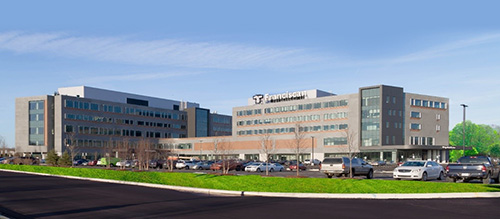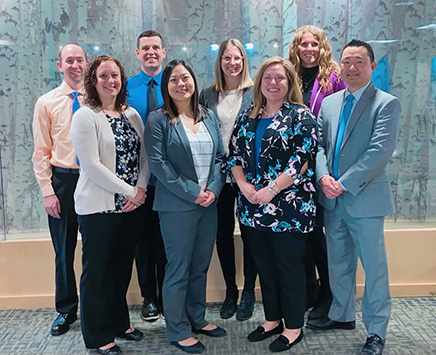
Franciscan Health – Mishawaka, IN
Establishing a Health System Outpatient Pharmacy Network
Submitted by Joshua Bitner, PharmD
Case Study Overview
Franciscan Health created and operationalized a health-system outpatient pharmacy network to influence patient, employee, and health plan initiatives from a service line offering, clinical, and financial perspective.
 Program Description
Program Description
Franciscan Health opened and embedded six, outpatient pharmacies onsite at the health system’s six flagship hospitals with the goal of creating value, both clinical and financial, for patients, employees, and the institution’s self-funded health plan. The objective was to align all outpatient pharmacy activities and services offerings with the health system’s overall strategic plan.
Primary Intended Outcomes
The primary objectives for developing the outpatient network within the health system were:
- Effective management of employee prescriptions:
- Access: Our pharmacies provided an in-house option for our employees to easily fill their prescriptions at each of our 6 core hospitals, while also adding courier servicing to all smaller satellite hospitals where there was no embedded outpatient pharmacy. In addition, we have begun implementing prescription kiosks for our non-hospital locations where we have a large employee base.
- Affordability: Our employees were incentivized, with reduced copays, to fill their prescriptions at our pharmacies.
- Medication Education & Adherence: By providing convenient access at a reduced cost, we hoped to synergistically influence adherence through education.
- Savings to self-funded employee health plan: An educated and medication compliant employee is a healthier, happier employee, which could ultimately reduce costs to our self-funded health plan.
- Reduction of 30-day readmissions:
- Initiation of a Meds-to-Bed Program:
- The primary goal was to ensure that all medications barriers (getting the actual medication(s), education, access, cost) were alleviated upon discharge by providing convenient service for both the patient, family, and/or caregiver(s).
- If the primary objectives were met, we hoped this would influence overall patient satisfaction.
- Initiation of a Meds-to-Bed Program:
- Financial profitability:
- Positive contribution margin to maintain and grow service line offerings/programs, staff, to incorporate more cutting-edge technology, and to ensure short- and long-term sustainability and viability as a business unit.
Site Description
The outpatient pharmacies are a segment of a 13-hospital health system, with various associated outpatient sites/clinics, as well as a multi-site system wide physician network. We opened our network of pharmacies in 2017.
The primary patient populations are employees and discharging patients. Secondary populations include those patients from the surrounding community. The health system’s outpatient pharmacies average between 200-500 prescriptions per day.
The pharmacy services align with our overall objectives of fulfilling the needs of our employees, non-employees, and discharging patients by providing:
- Ease of filling both non-specialty, specialty, and over-the-counter medications.
- Meds-to-Bed servicing for discharging patient prescriptions.
- Coordinated patient assistance via charity care programs, our own foundation, and leveraging manufacturer assistance programs.
- Immunization services (COVID and non-COVID)
- Medication therapy management, if eligible, via PBM based platforms.
- Medication Synchronization to help with adherence, save redundant patient trips to pharmacy, and decrease production inefficiencies in the pharmacy.
- Diabetic devices and supplies that are not readily stocked at traditional pharmacies.
- DME products that are not readily stocked at traditional pharmacies.
- OTCs products that are most commonly used.
 Key Elements of Success
Key Elements of Success
In order to be successful, some key elements must exist:
- Creating a sound financial and clinical strategic plan:
- Effort and time must be spent mapping out your anticipated road to success with well-defined objectives, endpoints, and strategies to keep on schedule from a timing perspective.
- Establishing financial and/or clinical metrics to measure success.
- It is extremely important that the outpatient pharmacies integrate seamlessly with their unique hospital cultures and distinct initiatives.
- Continuous evaluation of current service lines as well expansion of service lines.
- Hiring the right people is the single most important aspect in the successful implementation of the objectives set forth in the plan. Seek out the most talented people with the characteristics that you value as “must haves”. Candidates may not check all of boxes in your initial evaluation, but must encompass high ceiling potential and a good baseline floor. Sometimes you may have to keep a position open for an extended period in order to find that great fit:
- My four personal “must haves” are strong morals/ethics, elite problem-solving abilities, strong interpersonal and communication abilities, and an undeniable will/tenacity to succeed.
- If you can find a person that has the above traits and is creative as well, then you have truly found a rare individual that is a “must have”.
- Creating a strong leadership structure based on consistent core philosophies/beliefs and being resolute and unwavering. The foundation must be strong, with clear expectations from the beginning.
- Creating a culture which is inclusive, fosters creativity and innovation, allows for autonomy, and nurtures family type relationships among the entire business unit. Objectives must be conveyed in a clear, concise, and consistent communication methodology.
- Becoming comfortable and “resting on your laurels” is the biggest threat to continued success. To combat complacency:
- Maintain constant and consistent 360 communication at all levels.
- Constant self-evaluation.
- Continuous self and business evolution.
- Maintaining flexibility and adaptability.
- Continuous analysis of objective and subjective data.
- Awareness of industry.
- Analysis of opportunities and threats.
Outcomes, Measures, or Evaluations for Program
- Continuous analysis of objective and subjective data is required to better understand your entire business:
- Operating Margin: At the end of 3 years our 6 outpatient pharmacies had a consolidated positive contribution margin. Each of the 6 outpatient pharmacies evolved differently to get to a profitable state, ranging between a 1 to 3 year time frame due to different demographics and opportunities.
- Self-funded Health Plan Savings: Approximately ~80% of all employee medication dollars spent are at our own pharmacies. It took ~5 years, from a consolidated perspective, to get this level.
- Reduction of 30-day readmissions: For those discharging patients that participate in our Meds-to-Bed program, there has been a 32% relative reduction vs. nonparticipants in readmissions.
- Script Volume: ~30% average year over year increases in volume. We continue to grow, but there will be a time when this percentage levels off.
- Employee and Non-employee Satisfaction: From an employee and patient perspective we have received direct and indirect positive verbal and written feedback throughout the health system. In 2022, we are planning to implement a patient satisfaction survey.
Lessons Learned
- Have a well thought-out strategic plan from the beginning and an unwavering belief and resolve that the endeavor will ultimately be successful.
- Identifying, hiring, and developing talented people to carry out the plan is essential. The most important determinant of success will always rely on the type of people within your organizational structure.
- At each step of the way, consider all alternatives.
- Stay true to the team’s core philosophies and the culture.
- Once success is achieved, continue to evolve, while eliminating complacency.
- Lean on your support. Our VP of Pharmacy Services, David Blazo, has always been and continues to be our biggest advocate.
Over the past 6 years the outpatient pharmacy teams have showcased their tremendous value, which has led to non-pharmacy senior leadership at both corporate and local hospital levels becoming our greatest champions. In hindsight, if there was one aspect that I might alter is our approach to focusing so much time on task-oriented objectives. We would refocus and spend more time creating, developing, and evolving more wide-ranging global priorities and objectives.
Future Goals
Our future goals focus around leveraging technology, such as cutting-edge hardware, software, machines, robots, etc. to enhance and expand current services and create new services. This investment in technology will allow us to increase efficiencies in all aspects of our business.
Member Only
Join ASHP today to get access to the full content
